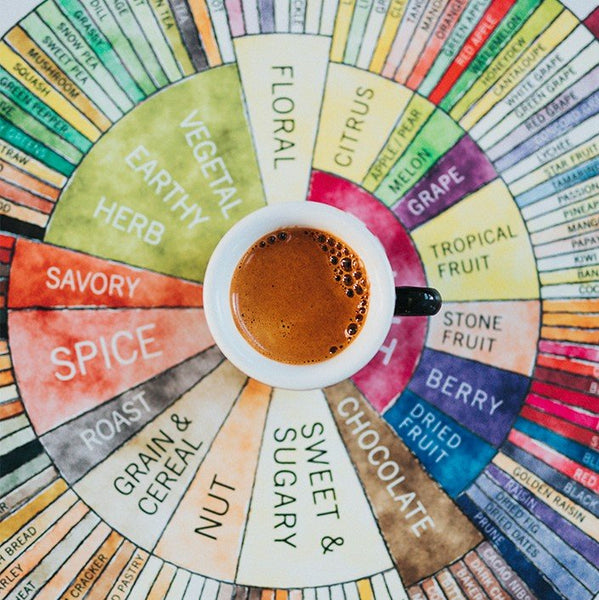Learning the language of coffee flavours is not only a great way to further appreciate the world of specialty coffee but also to discover why you might prefer one coffee over another.
The more coffee you consume, the more focused you will become on the inherent nuances.
We are talking top quality coffee here - avoid the supermarket if you are looking for complex flavour characteristics.
Coffee is chemically complex and contains more aroma molecules than wine. It takes years of cupping and learning about different varieties and origins to accurately perceive flavour notes.
A Q-Grader has the qualification to determine these notes and grade a coffee in terms of quality. While you needn’t aim this high, you can discover more by attending cupping events with your local roaster and even experimenting with your coffees at home.
Aroma and taste, are the overriding factors determining coffee preference. The Specialty Coffee Association of America created the first mapping of coffee's flavour profiles, which was performed around 20 years ago.
This resulted in what we know today as the Coffee Taster’s Flavour Wheel which you can view on the SCAA website. It’s not only super informative, but it also looks pretty cool too and makes for good wall art for the coffee aficionado!
You can find a multitude of subtle flavours in different coffees, as indicated on the flavour wheel, which like wine, are often associated with their aroma. Some of the most common flavour descriptors include:
- Chocolate
- Nutty
- Vegetal
- Spicy
- Fruity
Coffee tasting goes even deeper than aroma and flavour, however. We also discuss acidity, body, aftertaste and balance. It can be helpful to look at it in a pentagon or heptagon. Here is an example from one of our green bean suppliers. At a glance, this type of graphic is very helpful in guiding us to choose a coffee bean.

Acidity
While initially the word acidity doesn’t sound too appealing, acidity in the coffee world suggests a sharpness, tangy, fruit, sparkling, brightness with a dryness at the back of the mouth. Think crisp apple rather than sour lemon. Acidity denotes a high quality, high grown coffee that is set apart from the lesser, commodity-grade which will taste “flat” in comparison.
Body
Refers to the thickness or weight of the liquid against your tongue. Imagine the difference between honey on the mouth versus water. A bad coffee might feel oily, grainy, watery compared to a beautifully silky, buttery body. Body also helps the coffee to cut through milk, so a heavier body is ideal for milk-based espresso.
Sweetness
This one is easier for the novice! The sweet, pleasant flavour is enjoyed without any sense of harshness. Sometimes a fruity taste is evident at the tip of the tongue.
Balance
Balance refers to the notion that no one quality overwhelms all others, and that there is enough complexity in the coffee to be interesting and not flat.
Aftertaste
Also known as the finish, is the flavour that sits on your tongue after you have sipped your coffee. Hopefully, you will experience a pleasing aftertaste like chocolate, spice, fruitiness, nuts or caramel and not burnt, smokiness. A coffee’s aftertaste is created by vapours that are released from the residue that remains in the mouth after swallowing the coffee.

We hope this overview gives you a greater understanding of some of the descriptors on your coffee packaging. You might like to compare a few coffees at home and see what differences you notice.
This is best done without the hindrance of milk. However, there are further ways to make this process even better. We will cover these in our next post!

